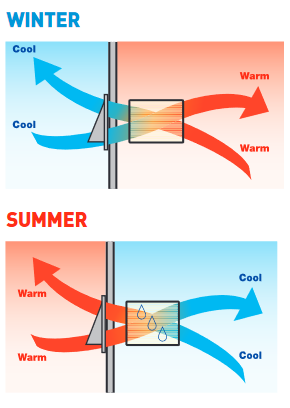Benefits of an ERV System (Energy Recovery Ventilator)


Benefits of ERV Systems (Energy Recovery Ventilator)
If you’re building a new home or doing a major renovations it’s very likely your builder will recommend and possibly insist that an Energy Recovery Ventilator (ERV) be installed. With new construction and renovations the building envelope is typically much more energy efficient and “tighter” than older construction. This results in stale air and high humidity levels being trapped inside your home resulting in poor air quality. ERV’s are designed to swap that stale and and moisture with fresh air that improves the overall indoor air quality.
ERV vs HRV – What’s The Difference?
If you’re having a conversation about installing this type of ventilation in your home it’s likely that you will hear one or two different types mentioned, ERV (Energy Recovery Ventilator) or HRV (Heat Recovery Ventilator). While they are similar there is one huge difference, ERV’s swap stale air for fresh air and transfer the heat (or cooling) and also transfer moisture. An HRV only transfers the heat (or cooling). HRV’s are less common and more appropriate for high humidity facilities like locker rooms or indoor pools. You’ll want an ERV unless you have a specific high humidity application.
How Does an ERV Work?
ERV’s are not overly complicated devices. In simple terms they exchange (swap) stale indoor air for fresh outdoor air. The “magic” is the ability to exchange the energy (temperature) of the indoor air and apply it to the outdoor air so there is little energy loss. It can work in both the Summer and Winter exchanging either warm or cool air depending on the time of year.
As you can see in the adjacent image the ERV captures whatever indoor temperature (energy) and transfers it to the fresh outdoor air. So if you’re bring in cold fresh air in the winter that fresh air is being warmed back up with the heat from the stale indoor air that is being exhausted. Similarly in the summer the hot fresh outdoor air is being cooled down with the stale indoor air that is being exhausted.
Hence the “recovery” name of these devices, they are recovering the energy from inside and saving it for the fresh air.
Types of ERV’s
Like anything in construction there are many options for ERV’s between Brands, sizes, and types. For the most part there are 3 different systems you can consider for your home when selecting an ERV. Your mechanical contractor can help you evaluate the different systems and what might be best for your home and budget. On the homes that I build we use one of the following three approaches.
- Integrated ERV Systems – Homes with forced air heating and cooling are great candidates to have an integrated ERV system. In an integrated system the ERV is connected to the forced air duct system. The beauty of this approach is you don’t need an independent duct system in place, reducing the overall cost of implementing the ERV. Systems like this require proper mechanical design and balancing of the complete duct work system in order to have a properly working and efficient system.
Costs of ERV Systems
Obviously you’ll want to know what an ERV will cost and what to expect. ERV system costs can vary greatly depending on the size of your home and the type that you select. Spot ERV systems will cost approximately $1,500 to $2,000 installed by time you buy the unit, duct hoses, exterior terminations and a control switch. Independent ERV systems can cost anywhere from $5,000 to $15,000 ore more depending on the size and amount of duct work required. Integrated ERV systems will cost $3,000 to $6,000 again depending on the size and how much additional duct work is required. Obviously pricing will vary greatly depending on where you live, Brands that are selected and the size of your home. Good quality indoor air isn’t cheap and it’s not something you should ignore.
Final Thoughts – ERV Systems
New homes and newly renovated homes can greatly benefit from a properly installed and sized ERV system. Modern construction is too air tight to rely on drafty construction to allow fresh air into your home. ERV’s are the best solution for ensuring your family is breathing good clean air. So if you’re building or renovating your home don’t hesitate to ask your builder about ERV options and make it a priority to install one.
Recent Posts
Framing Stick Nailer vs Coil Nailer
Which is Better a Stick Nailer or Coil Nailer? Framers have many choices in nailers…
How Many Roofing Nails Per Square of Shingles
Estimating How Many Nails for a New Roof When it comes to estimating materials for…
Composite / PVC Decking – Layout Tips & Advice
Composite / PVC Decking Layout Tips and Advice Composite and PVC decking have really changed…
Vermiculite Attic Insulation Abatement
Vermiculite Attic Insulation If your home was built before 1990 there is a chance it…
Nuisance Tripping of AFCI (Arc Fault) Circuit Breakers
Arc Fault (AFCI) Circuit Breakers Tripping Often An arc-fault circuit interrupter (AFCI) or arc-fault detection…
How To Build Floating Bar Shelves
Floating Walnut Bar Shelves Floating shelves are extremely popular and it's not a surprise due…
